Cert 4 Education Support: Assessment 1B on Workplace Health and Safety
VerifiedAdded on 2023/04/05
|18
|4710
|438
Homework Assignment
AI Summary
This assignment is a written submission for the Certificate IV in Education Support, focusing on workplace health and safety. It addresses legislative provisions, duty of care, hazard identification, and risk management within a school environment. The assignment includes responses to questions about the Work Health and Safety Act, roles in responding to illness, hazard identification methods, and a risk assessment based on a case study. The hierarchy of control is applied to manage identified risks, ensuring a safe working environment. This document is available on Desklib, a platform providing study tools and resources for students.
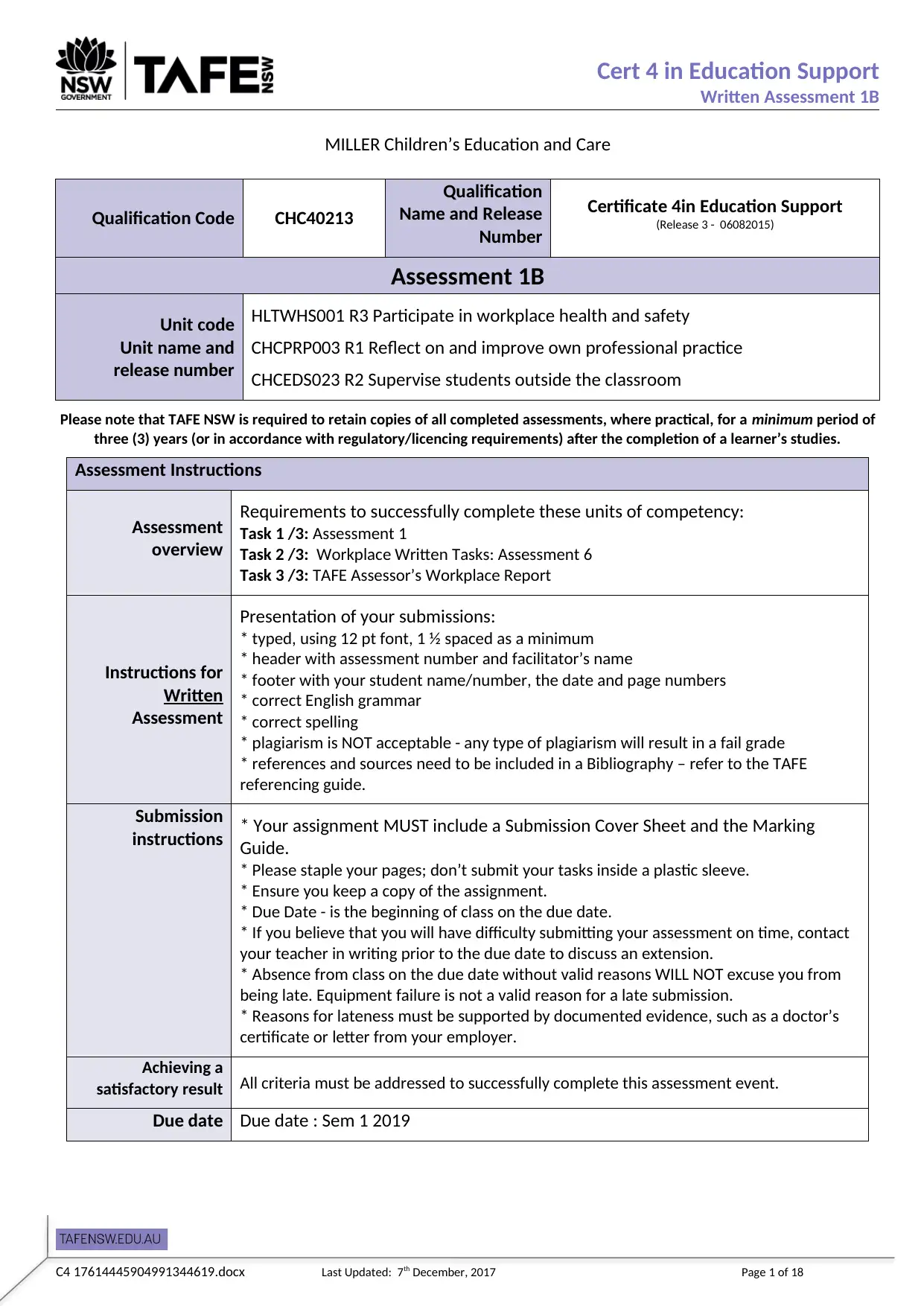
Cert 4 in Education Support
Written Assessment 1B
MILLER Children’s Education and Care
Qualification Code CHC40213
Qualification
Name and Release
Number
Certificate 4in Education Support
(Release 3 - 06082015)
Assessment 1B
Unit code
Unit name and
release number
HLTWHS001 R3 Participate in workplace health and safety
CHCPRP003 R1 Reflect on and improve own professional practice
CHCEDS023 R2 Supervise students outside the classroom
Please note that TAFE NSW is required to retain copies of all completed assessments, where practical, for a minimum period of
three (3) years (or in accordance with regulatory/licencing requirements) after the completion of a learner’s studies.
Assessment Instructions
Assessment
overview
Requirements to successfully complete these units of competency:
Task 1 /3: Assessment 1
Task 2 /3: Workplace Written Tasks: Assessment 6
Task 3 /3: TAFE Assessor’s Workplace Report
Instructions for
Written
Assessment
Presentation of your submissions:
* typed, using 12 pt font, 1 ½ spaced as a minimum
* header with assessment number and facilitator’s name
* footer with your student name/number, the date and page numbers
* correct English grammar
* correct spelling
* plagiarism is NOT acceptable - any type of plagiarism will result in a fail grade
* references and sources need to be included in a Bibliography – refer to the TAFE
referencing guide.
Submission
instructions * Your assignment MUST include a Submission Cover Sheet and the Marking
Guide.
* Please staple your pages; don’t submit your tasks inside a plastic sleeve.
* Ensure you keep a copy of the assignment.
* Due Date - is the beginning of class on the due date.
* If you believe that you will have difficulty submitting your assessment on time, contact
your teacher in writing prior to the due date to discuss an extension.
* Absence from class on the due date without valid reasons WILL NOT excuse you from
being late. Equipment failure is not a valid reason for a late submission.
* Reasons for lateness must be supported by documented evidence, such as a doctor’s
certificate or letter from your employer.
Achieving a
satisfactory result All criteria must be addressed to successfully complete this assessment event.
Due date Due date : Sem 1 2019
C4 17614445904991344619.docx Last Updated: 7th December, 2017 Page 1 of 18
Written Assessment 1B
MILLER Children’s Education and Care
Qualification Code CHC40213
Qualification
Name and Release
Number
Certificate 4in Education Support
(Release 3 - 06082015)
Assessment 1B
Unit code
Unit name and
release number
HLTWHS001 R3 Participate in workplace health and safety
CHCPRP003 R1 Reflect on and improve own professional practice
CHCEDS023 R2 Supervise students outside the classroom
Please note that TAFE NSW is required to retain copies of all completed assessments, where practical, for a minimum period of
three (3) years (or in accordance with regulatory/licencing requirements) after the completion of a learner’s studies.
Assessment Instructions
Assessment
overview
Requirements to successfully complete these units of competency:
Task 1 /3: Assessment 1
Task 2 /3: Workplace Written Tasks: Assessment 6
Task 3 /3: TAFE Assessor’s Workplace Report
Instructions for
Written
Assessment
Presentation of your submissions:
* typed, using 12 pt font, 1 ½ spaced as a minimum
* header with assessment number and facilitator’s name
* footer with your student name/number, the date and page numbers
* correct English grammar
* correct spelling
* plagiarism is NOT acceptable - any type of plagiarism will result in a fail grade
* references and sources need to be included in a Bibliography – refer to the TAFE
referencing guide.
Submission
instructions * Your assignment MUST include a Submission Cover Sheet and the Marking
Guide.
* Please staple your pages; don’t submit your tasks inside a plastic sleeve.
* Ensure you keep a copy of the assignment.
* Due Date - is the beginning of class on the due date.
* If you believe that you will have difficulty submitting your assessment on time, contact
your teacher in writing prior to the due date to discuss an extension.
* Absence from class on the due date without valid reasons WILL NOT excuse you from
being late. Equipment failure is not a valid reason for a late submission.
* Reasons for lateness must be supported by documented evidence, such as a doctor’s
certificate or letter from your employer.
Achieving a
satisfactory result All criteria must be addressed to successfully complete this assessment event.
Due date Due date : Sem 1 2019
C4 17614445904991344619.docx Last Updated: 7th December, 2017 Page 1 of 18
Paraphrase This Document
Need a fresh take? Get an instant paraphrase of this document with our AI Paraphraser
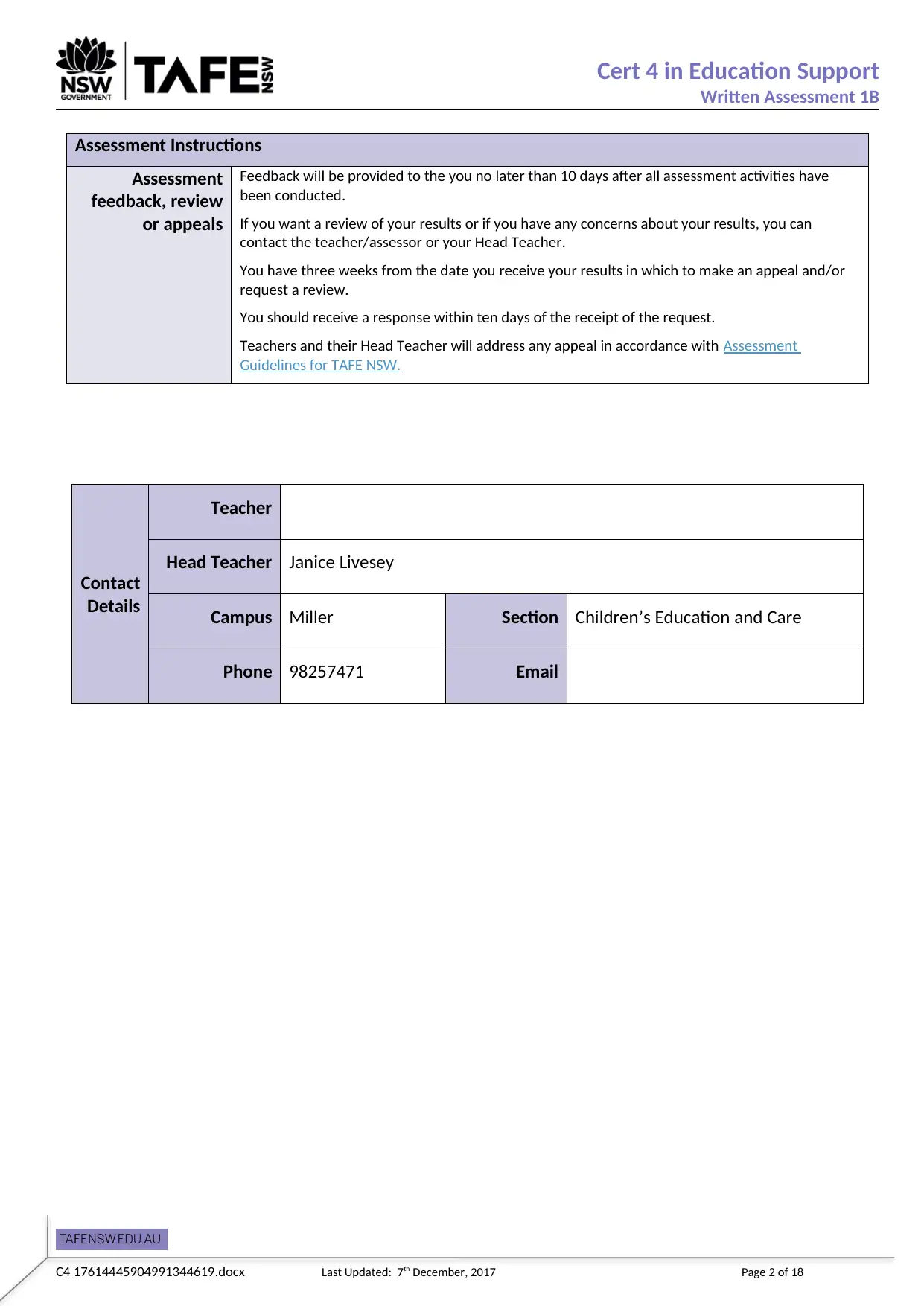
Cert 4 in Education Support
Written Assessment 1B
Assessment Instructions
Assessment
feedback, review
or appeals
Feedback will be provided to the you no later than 10 days after all assessment activities have
been conducted.
If you want a review of your results or if you have any concerns about your results, you can
contact the teacher/assessor or your Head Teacher.
You have three weeks from the date you receive your results in which to make an appeal and/or
request a review.
You should receive a response within ten days of the receipt of the request.
Teachers and their Head Teacher will address any appeal in accordance with Assessment
Guidelines for TAFE NSW.
Contact
Details
Teacher
Head Teacher Janice Livesey
Campus Miller Section Children’s Education and Care
Phone 98257471 Email
C4 17614445904991344619.docx Last Updated: 7th December, 2017 Page 2 of 18
Written Assessment 1B
Assessment Instructions
Assessment
feedback, review
or appeals
Feedback will be provided to the you no later than 10 days after all assessment activities have
been conducted.
If you want a review of your results or if you have any concerns about your results, you can
contact the teacher/assessor or your Head Teacher.
You have three weeks from the date you receive your results in which to make an appeal and/or
request a review.
You should receive a response within ten days of the receipt of the request.
Teachers and their Head Teacher will address any appeal in accordance with Assessment
Guidelines for TAFE NSW.
Contact
Details
Teacher
Head Teacher Janice Livesey
Campus Miller Section Children’s Education and Care
Phone 98257471 Email
C4 17614445904991344619.docx Last Updated: 7th December, 2017 Page 2 of 18
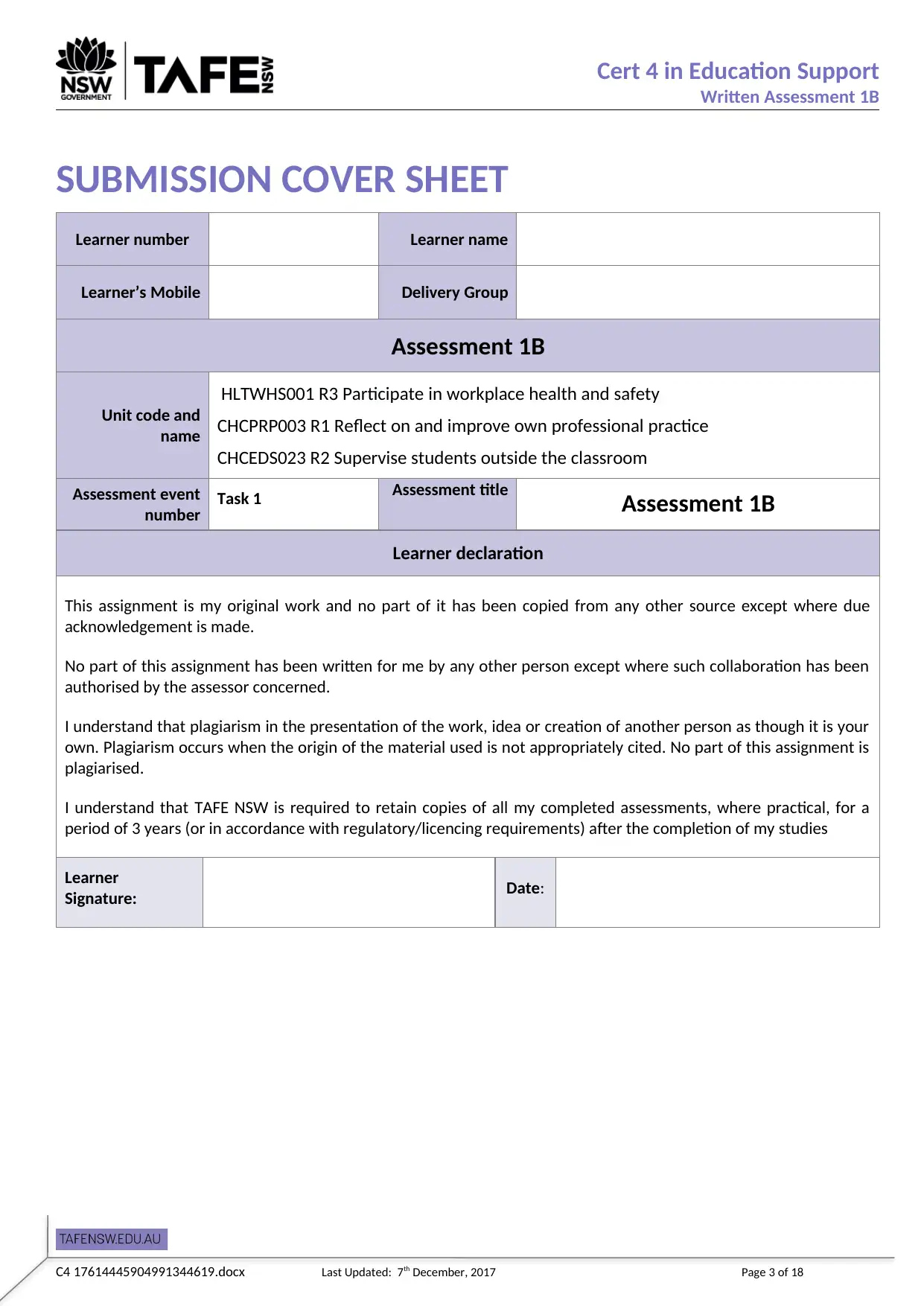
Cert 4 in Education Support
Written Assessment 1B
SUBMISSION COVER SHEET
Learner number Learner name
Learner’s Mobile Delivery Group
Assessment 1B
Unit code and
name
HLTWHS001 R3 Participate in workplace health and safety
CHCPRP003 R1 Reflect on and improve own professional practice
CHCEDS023 R2 Supervise students outside the classroom
Assessment event
number Task 1 Assessment title Assessment 1B
Learner declaration
This assignment is my original work and no part of it has been copied from any other source except where due
acknowledgement is made.
No part of this assignment has been written for me by any other person except where such collaboration has been
authorised by the assessor concerned.
I understand that plagiarism in the presentation of the work, idea or creation of another person as though it is your
own. Plagiarism occurs when the origin of the material used is not appropriately cited. No part of this assignment is
plagiarised.
I understand that TAFE NSW is required to retain copies of all my completed assessments, where practical, for a
period of 3 years (or in accordance with regulatory/licencing requirements) after the completion of my studies
Learner
Signature: Date:
C4 17614445904991344619.docx Last Updated: 7th December, 2017 Page 3 of 18
Written Assessment 1B
SUBMISSION COVER SHEET
Learner number Learner name
Learner’s Mobile Delivery Group
Assessment 1B
Unit code and
name
HLTWHS001 R3 Participate in workplace health and safety
CHCPRP003 R1 Reflect on and improve own professional practice
CHCEDS023 R2 Supervise students outside the classroom
Assessment event
number Task 1 Assessment title Assessment 1B
Learner declaration
This assignment is my original work and no part of it has been copied from any other source except where due
acknowledgement is made.
No part of this assignment has been written for me by any other person except where such collaboration has been
authorised by the assessor concerned.
I understand that plagiarism in the presentation of the work, idea or creation of another person as though it is your
own. Plagiarism occurs when the origin of the material used is not appropriately cited. No part of this assignment is
plagiarised.
I understand that TAFE NSW is required to retain copies of all my completed assessments, where practical, for a
period of 3 years (or in accordance with regulatory/licencing requirements) after the completion of my studies
Learner
Signature: Date:
C4 17614445904991344619.docx Last Updated: 7th December, 2017 Page 3 of 18
⊘ This is a preview!⊘
Do you want full access?
Subscribe today to unlock all pages.

Trusted by 1+ million students worldwide
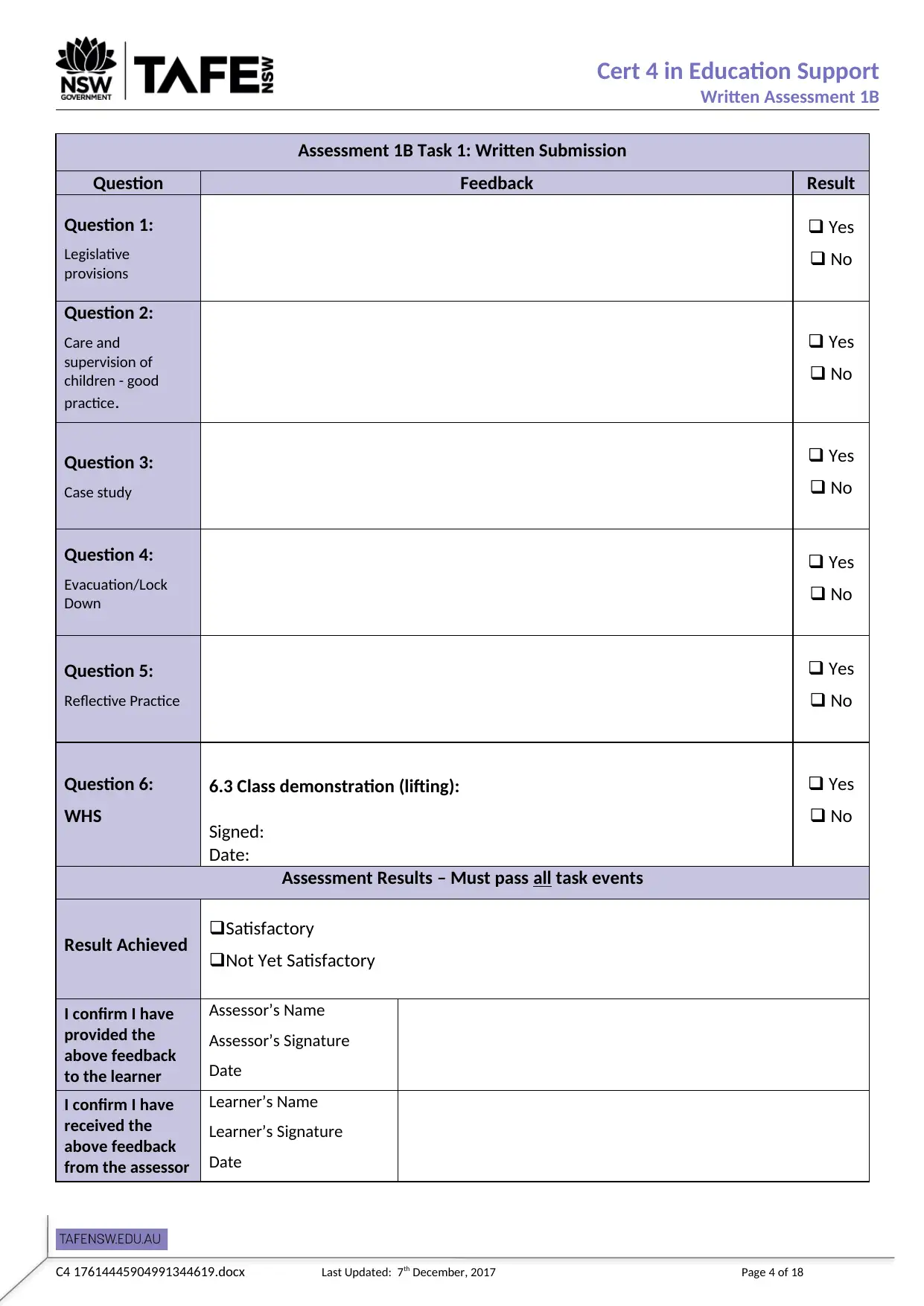
Cert 4 in Education Support
Written Assessment 1B
Assessment 1B Task 1: Written Submission
Question Feedback Result
Question 1:
Legislative
provisions
Yes
No
Question 2:
Care and
supervision of
children - good
practice.
Yes
No
Question 3:
Case study
Yes
No
Question 4:
Evacuation/Lock
Down
Yes
No
Question 5:
Reflective Practice
Yes
No
Question 6:
WHS
6.3 Class demonstration (lifting):
Signed:
Date:
Yes
No
Assessment Results – Must pass all task events
Result Achieved Satisfactory
Not Yet Satisfactory
I confirm I have
provided the
above feedback
to the learner
Assessor’s Name
Assessor’s Signature
Date
I confirm I have
received the
above feedback
from the assessor
Learner’s Name
Learner’s Signature
Date
C4 17614445904991344619.docx Last Updated: 7th December, 2017 Page 4 of 18
Written Assessment 1B
Assessment 1B Task 1: Written Submission
Question Feedback Result
Question 1:
Legislative
provisions
Yes
No
Question 2:
Care and
supervision of
children - good
practice.
Yes
No
Question 3:
Case study
Yes
No
Question 4:
Evacuation/Lock
Down
Yes
No
Question 5:
Reflective Practice
Yes
No
Question 6:
WHS
6.3 Class demonstration (lifting):
Signed:
Date:
Yes
No
Assessment Results – Must pass all task events
Result Achieved Satisfactory
Not Yet Satisfactory
I confirm I have
provided the
above feedback
to the learner
Assessor’s Name
Assessor’s Signature
Date
I confirm I have
received the
above feedback
from the assessor
Learner’s Name
Learner’s Signature
Date
C4 17614445904991344619.docx Last Updated: 7th December, 2017 Page 4 of 18
Paraphrase This Document
Need a fresh take? Get an instant paraphrase of this document with our AI Paraphraser
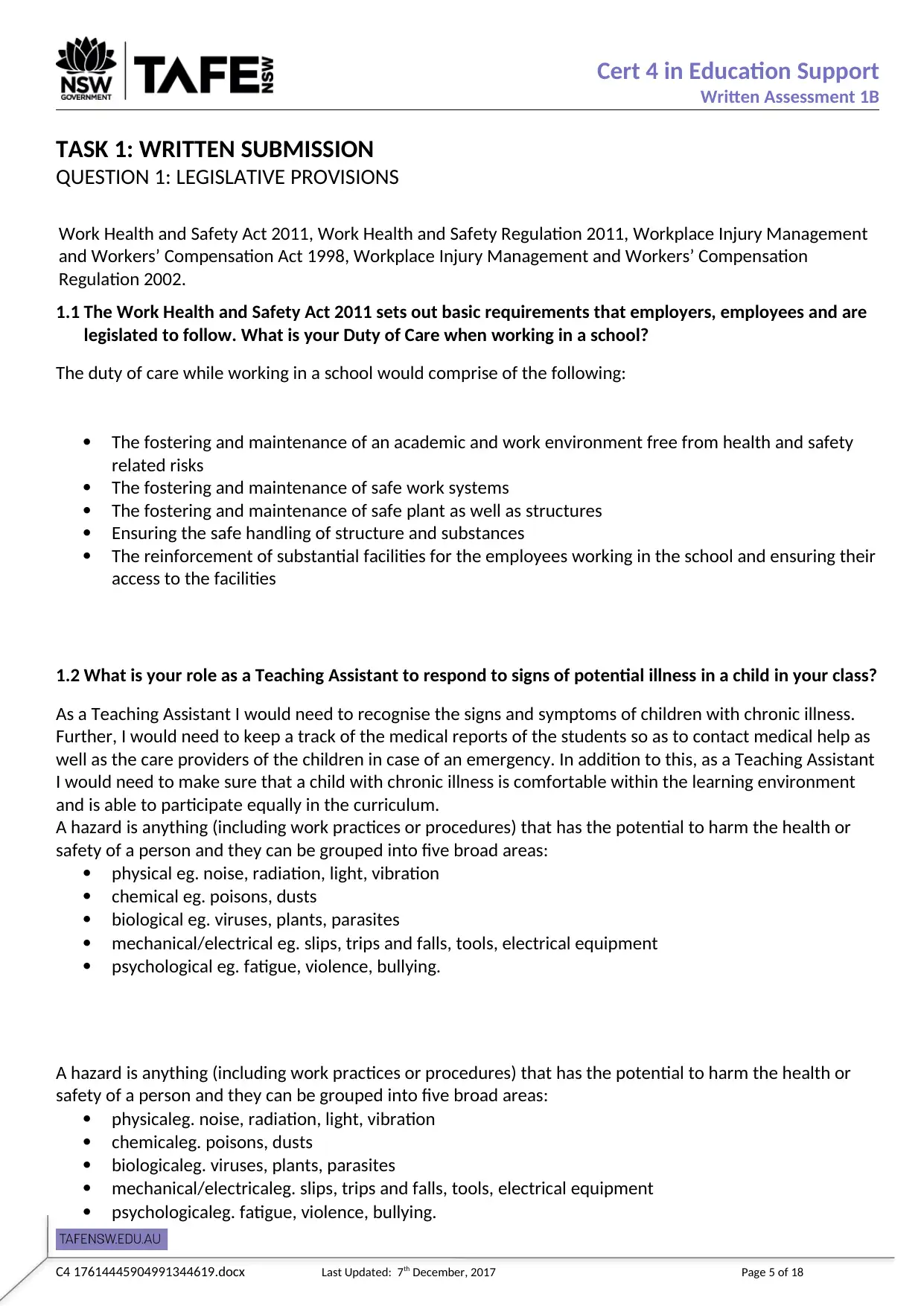
Cert 4 in Education Support
Written Assessment 1B
TASK 1: WRITTEN SUBMISSION
QUESTION 1: LEGISLATIVE PROVISIONS
Work Health and Safety Act 2011, Work Health and Safety Regulation 2011, Workplace Injury Management
and Workers’ Compensation Act 1998, Workplace Injury Management and Workers’ Compensation
Regulation 2002.
1.1 The Work Health and Safety Act 2011 sets out basic requirements that employers, employees and are
legislated to follow. What is your Duty of Care when working in a school?
The duty of care while working in a school would comprise of the following:
The fostering and maintenance of an academic and work environment free from health and safety
related risks
The fostering and maintenance of safe work systems
The fostering and maintenance of safe plant as well as structures
Ensuring the safe handling of structure and substances
The reinforcement of substantial facilities for the employees working in the school and ensuring their
access to the facilities
1.2 What is your role as a Teaching Assistant to respond to signs of potential illness in a child in your class?
As a Teaching Assistant I would need to recognise the signs and symptoms of children with chronic illness.
Further, I would need to keep a track of the medical reports of the students so as to contact medical help as
well as the care providers of the children in case of an emergency. In addition to this, as a Teaching Assistant
I would need to make sure that a child with chronic illness is comfortable within the learning environment
and is able to participate equally in the curriculum.
A hazard is anything (including work practices or procedures) that has the potential to harm the health or
safety of a person and they can be grouped into five broad areas:
physical eg. noise, radiation, light, vibration
chemical eg. poisons, dusts
biological eg. viruses, plants, parasites
mechanical/electrical eg. slips, trips and falls, tools, electrical equipment
psychological eg. fatigue, violence, bullying.
A hazard is anything (including work practices or procedures) that has the potential to harm the health or
safety of a person and they can be grouped into five broad areas:
physicaleg. noise, radiation, light, vibration
chemicaleg. poisons, dusts
biologicaleg. viruses, plants, parasites
mechanical/electricaleg. slips, trips and falls, tools, electrical equipment
psychologicaleg. fatigue, violence, bullying.
C4 17614445904991344619.docx Last Updated: 7th December, 2017 Page 5 of 18
Written Assessment 1B
TASK 1: WRITTEN SUBMISSION
QUESTION 1: LEGISLATIVE PROVISIONS
Work Health and Safety Act 2011, Work Health and Safety Regulation 2011, Workplace Injury Management
and Workers’ Compensation Act 1998, Workplace Injury Management and Workers’ Compensation
Regulation 2002.
1.1 The Work Health and Safety Act 2011 sets out basic requirements that employers, employees and are
legislated to follow. What is your Duty of Care when working in a school?
The duty of care while working in a school would comprise of the following:
The fostering and maintenance of an academic and work environment free from health and safety
related risks
The fostering and maintenance of safe work systems
The fostering and maintenance of safe plant as well as structures
Ensuring the safe handling of structure and substances
The reinforcement of substantial facilities for the employees working in the school and ensuring their
access to the facilities
1.2 What is your role as a Teaching Assistant to respond to signs of potential illness in a child in your class?
As a Teaching Assistant I would need to recognise the signs and symptoms of children with chronic illness.
Further, I would need to keep a track of the medical reports of the students so as to contact medical help as
well as the care providers of the children in case of an emergency. In addition to this, as a Teaching Assistant
I would need to make sure that a child with chronic illness is comfortable within the learning environment
and is able to participate equally in the curriculum.
A hazard is anything (including work practices or procedures) that has the potential to harm the health or
safety of a person and they can be grouped into five broad areas:
physical eg. noise, radiation, light, vibration
chemical eg. poisons, dusts
biological eg. viruses, plants, parasites
mechanical/electrical eg. slips, trips and falls, tools, electrical equipment
psychological eg. fatigue, violence, bullying.
A hazard is anything (including work practices or procedures) that has the potential to harm the health or
safety of a person and they can be grouped into five broad areas:
physicaleg. noise, radiation, light, vibration
chemicaleg. poisons, dusts
biologicaleg. viruses, plants, parasites
mechanical/electricaleg. slips, trips and falls, tools, electrical equipment
psychologicaleg. fatigue, violence, bullying.
C4 17614445904991344619.docx Last Updated: 7th December, 2017 Page 5 of 18
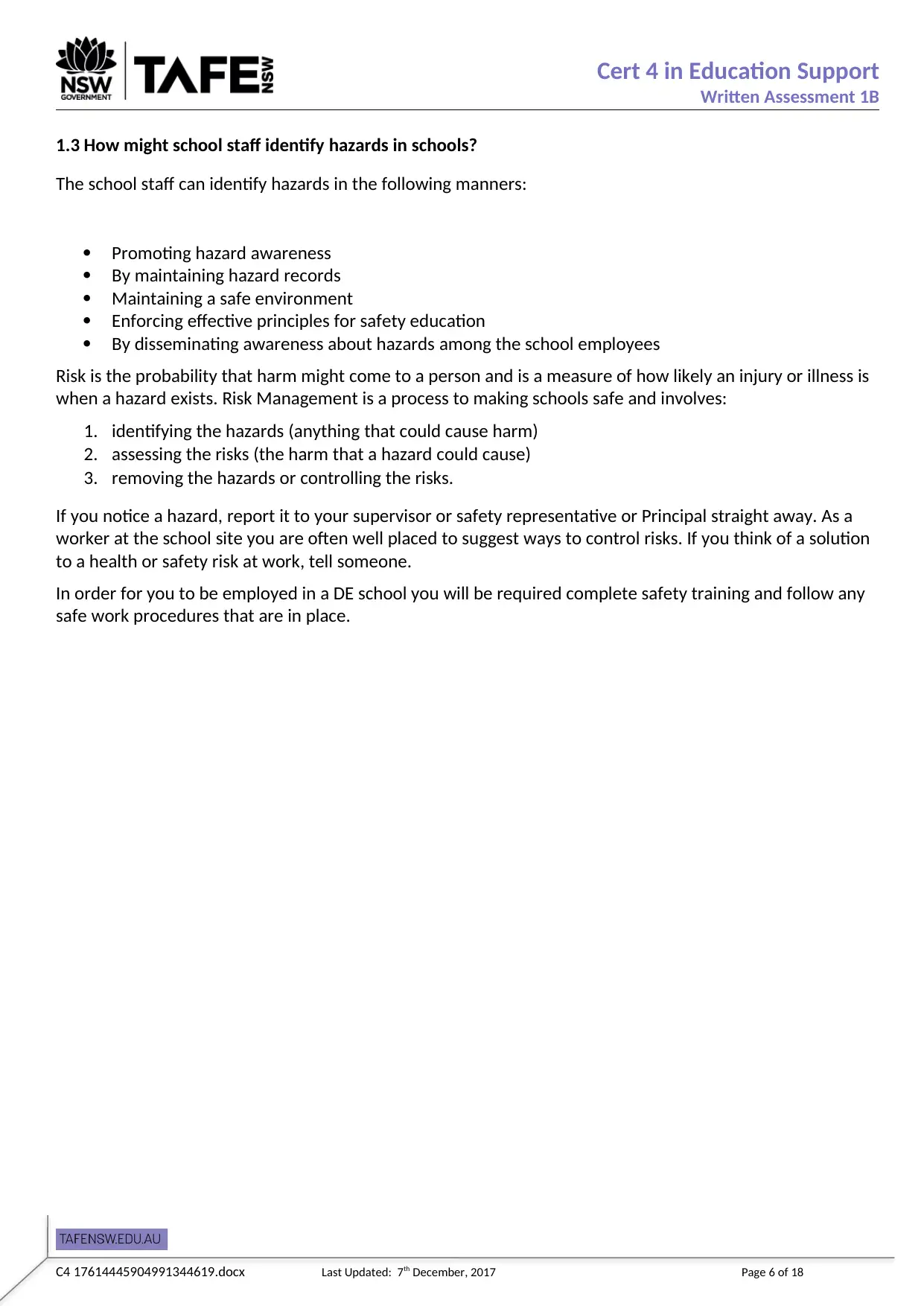
Cert 4 in Education Support
Written Assessment 1B
1.3 How might school staff identify hazards in schools?
The school staff can identify hazards in the following manners:
Promoting hazard awareness
By maintaining hazard records
Maintaining a safe environment
Enforcing effective principles for safety education
By disseminating awareness about hazards among the school employees
Risk is the probability that harm might come to a person and is a measure of how likely an injury or illness is
when a hazard exists. Risk Management is a process to making schools safe and involves:
1. identifying the hazards (anything that could cause harm)
2. assessing the risks (the harm that a hazard could cause)
3. removing the hazards or controlling the risks.
If you notice a hazard, report it to your supervisor or safety representative or Principal straight away. As a
worker at the school site you are often well placed to suggest ways to control risks. If you think of a solution
to a health or safety risk at work, tell someone.
In order for you to be employed in a DE school you will be required complete safety training and follow any
safe work procedures that are in place.
C4 17614445904991344619.docx Last Updated: 7th December, 2017 Page 6 of 18
Written Assessment 1B
1.3 How might school staff identify hazards in schools?
The school staff can identify hazards in the following manners:
Promoting hazard awareness
By maintaining hazard records
Maintaining a safe environment
Enforcing effective principles for safety education
By disseminating awareness about hazards among the school employees
Risk is the probability that harm might come to a person and is a measure of how likely an injury or illness is
when a hazard exists. Risk Management is a process to making schools safe and involves:
1. identifying the hazards (anything that could cause harm)
2. assessing the risks (the harm that a hazard could cause)
3. removing the hazards or controlling the risks.
If you notice a hazard, report it to your supervisor or safety representative or Principal straight away. As a
worker at the school site you are often well placed to suggest ways to control risks. If you think of a solution
to a health or safety risk at work, tell someone.
In order for you to be employed in a DE school you will be required complete safety training and follow any
safe work procedures that are in place.
C4 17614445904991344619.docx Last Updated: 7th December, 2017 Page 6 of 18
⊘ This is a preview!⊘
Do you want full access?
Subscribe today to unlock all pages.

Trusted by 1+ million students worldwide
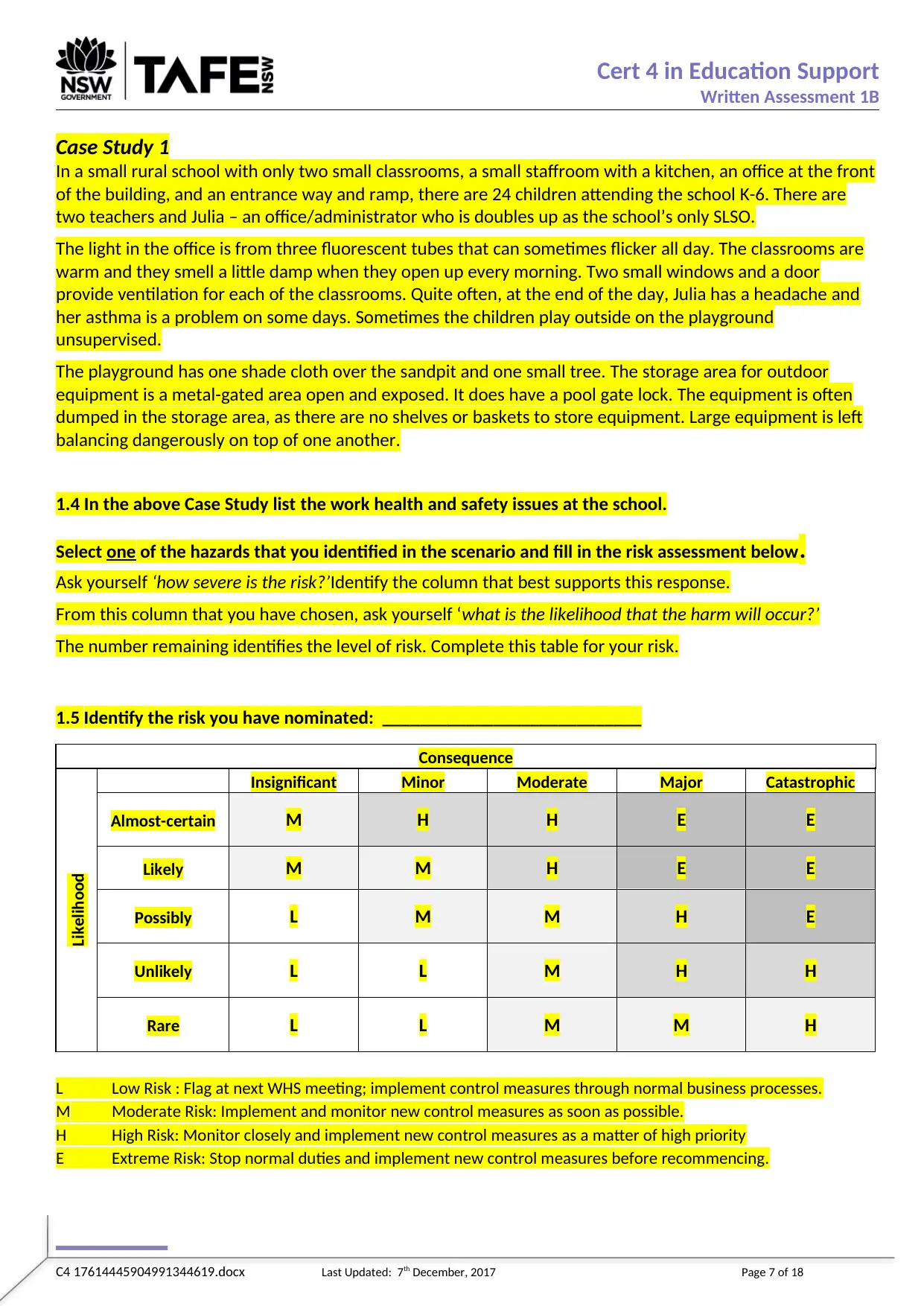
Cert 4 in Education Support
Written Assessment 1B
Case Study 1
In a small rural school with only two small classrooms, a small staffroom with a kitchen, an office at the front
of the building, and an entrance way and ramp, there are 24 children attending the school K-6. There are
two teachers and Julia – an office/administrator who is doubles up as the school’s only SLSO.
The light in the office is from three fluorescent tubes that can sometimes flicker all day. The classrooms are
warm and they smell a little damp when they open up every morning. Two small windows and a door
provide ventilation for each of the classrooms. Quite often, at the end of the day, Julia has a headache and
her asthma is a problem on some days. Sometimes the children play outside on the playground
unsupervised.
The playground has one shade cloth over the sandpit and one small tree. The storage area for outdoor
equipment is a metal-gated area open and exposed. It does have a pool gate lock. The equipment is often
dumped in the storage area, as there are no shelves or baskets to store equipment. Large equipment is left
balancing dangerously on top of one another.
1.4 In the above Case Study list the work health and safety issues at the school.
Select one of the hazards that you identified in the scenario and fill in the risk assessment below.
Ask yourself ‘how severe is the risk?’Identify the column that best supports this response.
From this column that you have chosen, ask yourself ‘what is the likelihood that the harm will occur?’
The number remaining identifies the level of risk. Complete this table for your risk.
1.5 Identify the risk you have nominated: ____________________________
Consequence
Likelihood
Insignificant Minor Moderate Major Catastrophic
Almost-certain M H H E E
Likely M M H E E
Possibly L M M H E
Unlikely L L M H H
Rare L L M M H
L Low Risk : Flag at next WHS meeting; implement control measures through normal business processes.
M Moderate Risk: Implement and monitor new control measures as soon as possible.
H High Risk: Monitor closely and implement new control measures as a matter of high priority
E Extreme Risk: Stop normal duties and implement new control measures before recommencing.
C4 17614445904991344619.docx Last Updated: 7th December, 2017 Page 7 of 18
Written Assessment 1B
Case Study 1
In a small rural school with only two small classrooms, a small staffroom with a kitchen, an office at the front
of the building, and an entrance way and ramp, there are 24 children attending the school K-6. There are
two teachers and Julia – an office/administrator who is doubles up as the school’s only SLSO.
The light in the office is from three fluorescent tubes that can sometimes flicker all day. The classrooms are
warm and they smell a little damp when they open up every morning. Two small windows and a door
provide ventilation for each of the classrooms. Quite often, at the end of the day, Julia has a headache and
her asthma is a problem on some days. Sometimes the children play outside on the playground
unsupervised.
The playground has one shade cloth over the sandpit and one small tree. The storage area for outdoor
equipment is a metal-gated area open and exposed. It does have a pool gate lock. The equipment is often
dumped in the storage area, as there are no shelves or baskets to store equipment. Large equipment is left
balancing dangerously on top of one another.
1.4 In the above Case Study list the work health and safety issues at the school.
Select one of the hazards that you identified in the scenario and fill in the risk assessment below.
Ask yourself ‘how severe is the risk?’Identify the column that best supports this response.
From this column that you have chosen, ask yourself ‘what is the likelihood that the harm will occur?’
The number remaining identifies the level of risk. Complete this table for your risk.
1.5 Identify the risk you have nominated: ____________________________
Consequence
Likelihood
Insignificant Minor Moderate Major Catastrophic
Almost-certain M H H E E
Likely M M H E E
Possibly L M M H E
Unlikely L L M H H
Rare L L M M H
L Low Risk : Flag at next WHS meeting; implement control measures through normal business processes.
M Moderate Risk: Implement and monitor new control measures as soon as possible.
H High Risk: Monitor closely and implement new control measures as a matter of high priority
E Extreme Risk: Stop normal duties and implement new control measures before recommencing.
C4 17614445904991344619.docx Last Updated: 7th December, 2017 Page 7 of 18
Paraphrase This Document
Need a fresh take? Get an instant paraphrase of this document with our AI Paraphraser
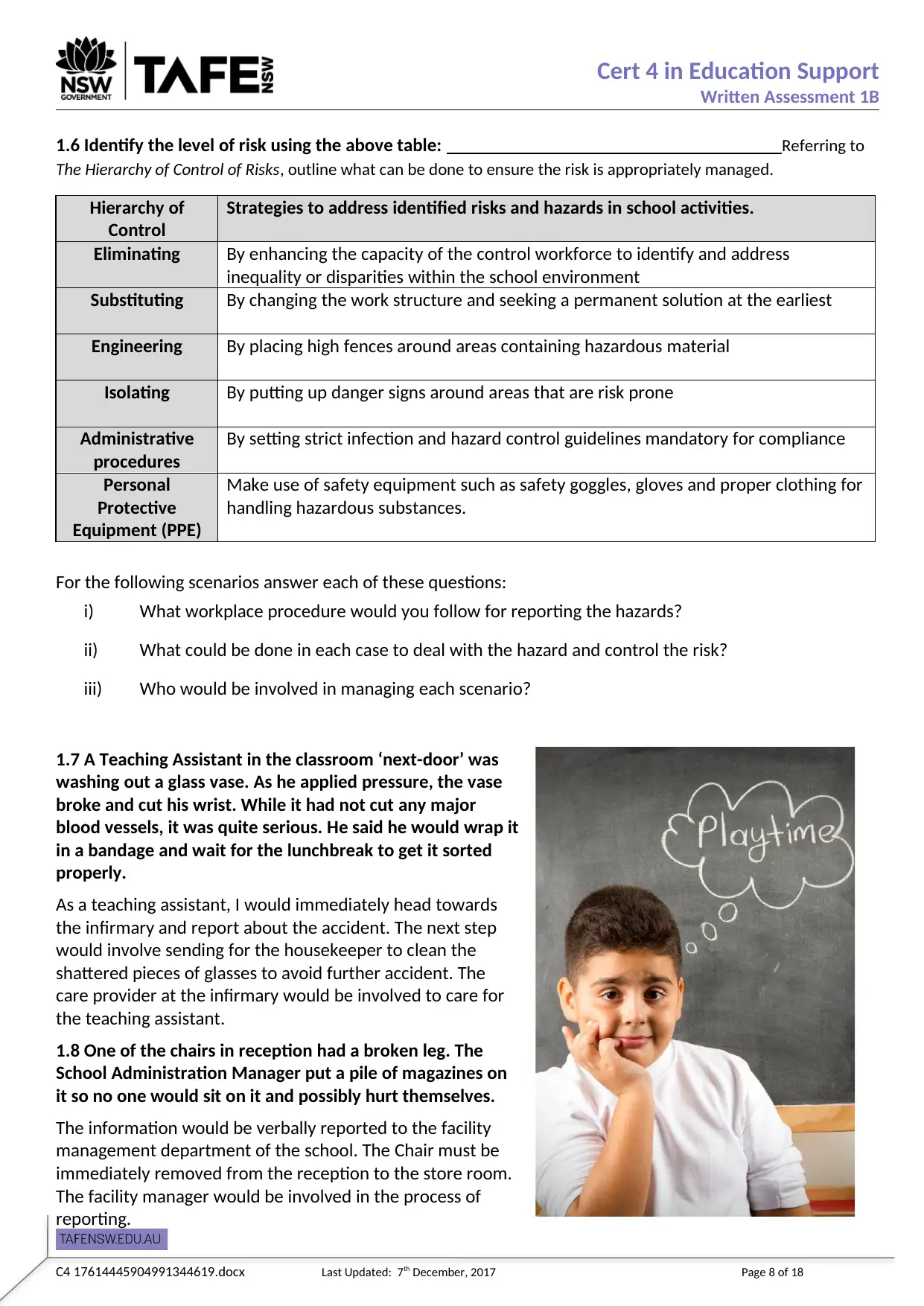
Cert 4 in Education Support
Written Assessment 1B
1.6 Identify the level of risk using the above table: Referring to
The Hierarchy of Control of Risks, outline what can be done to ensure the risk is appropriately managed.
Hierarchy of
Control
Strategies to address identified risks and hazards in school activities.
Eliminating By enhancing the capacity of the control workforce to identify and address
inequality or disparities within the school environment
Substituting By changing the work structure and seeking a permanent solution at the earliest
Engineering By placing high fences around areas containing hazardous material
Isolating By putting up danger signs around areas that are risk prone
Administrative
procedures
By setting strict infection and hazard control guidelines mandatory for compliance
Personal
Protective
Equipment (PPE)
Make use of safety equipment such as safety goggles, gloves and proper clothing for
handling hazardous substances.
For the following scenarios answer each of these questions:
i) What workplace procedure would you follow for reporting the hazards?
ii) What could be done in each case to deal with the hazard and control the risk?
iii) Who would be involved in managing each scenario?
1.7 A Teaching Assistant in the classroom ‘next-door’ was
washing out a glass vase. As he applied pressure, the vase
broke and cut his wrist. While it had not cut any major
blood vessels, it was quite serious. He said he would wrap it
in a bandage and wait for the lunchbreak to get it sorted
properly.
As a teaching assistant, I would immediately head towards
the infirmary and report about the accident. The next step
would involve sending for the housekeeper to clean the
shattered pieces of glasses to avoid further accident. The
care provider at the infirmary would be involved to care for
the teaching assistant.
1.8 One of the chairs in reception had a broken leg. The
School Administration Manager put a pile of magazines on
it so no one would sit on it and possibly hurt themselves.
The information would be verbally reported to the facility
management department of the school. The Chair must be
immediately removed from the reception to the store room.
The facility manager would be involved in the process of
reporting.
C4 17614445904991344619.docx Last Updated: 7th December, 2017 Page 8 of 18
Written Assessment 1B
1.6 Identify the level of risk using the above table: Referring to
The Hierarchy of Control of Risks, outline what can be done to ensure the risk is appropriately managed.
Hierarchy of
Control
Strategies to address identified risks and hazards in school activities.
Eliminating By enhancing the capacity of the control workforce to identify and address
inequality or disparities within the school environment
Substituting By changing the work structure and seeking a permanent solution at the earliest
Engineering By placing high fences around areas containing hazardous material
Isolating By putting up danger signs around areas that are risk prone
Administrative
procedures
By setting strict infection and hazard control guidelines mandatory for compliance
Personal
Protective
Equipment (PPE)
Make use of safety equipment such as safety goggles, gloves and proper clothing for
handling hazardous substances.
For the following scenarios answer each of these questions:
i) What workplace procedure would you follow for reporting the hazards?
ii) What could be done in each case to deal with the hazard and control the risk?
iii) Who would be involved in managing each scenario?
1.7 A Teaching Assistant in the classroom ‘next-door’ was
washing out a glass vase. As he applied pressure, the vase
broke and cut his wrist. While it had not cut any major
blood vessels, it was quite serious. He said he would wrap it
in a bandage and wait for the lunchbreak to get it sorted
properly.
As a teaching assistant, I would immediately head towards
the infirmary and report about the accident. The next step
would involve sending for the housekeeper to clean the
shattered pieces of glasses to avoid further accident. The
care provider at the infirmary would be involved to care for
the teaching assistant.
1.8 One of the chairs in reception had a broken leg. The
School Administration Manager put a pile of magazines on
it so no one would sit on it and possibly hurt themselves.
The information would be verbally reported to the facility
management department of the school. The Chair must be
immediately removed from the reception to the store room.
The facility manager would be involved in the process of
reporting.
C4 17614445904991344619.docx Last Updated: 7th December, 2017 Page 8 of 18

Cert 4 in Education Support
Written Assessment 1B
1.9 Your school decides to change over to a digital recording system for attendance rolls. One of the more
mature staff members gets quite upset and emotional about it as she does ‘not even understand how to
use her mobile phone properly’.
The teacher training department would be verbally reported about the inconvenience of the employees. A
short training workshop on the use of technology could help the teacher in taking the attendance. The
training department supervisor would be involved in the process.
C4 17614445904991344619.docx Last Updated: 7th December, 2017 Page 9 of 18
Written Assessment 1B
1.9 Your school decides to change over to a digital recording system for attendance rolls. One of the more
mature staff members gets quite upset and emotional about it as she does ‘not even understand how to
use her mobile phone properly’.
The teacher training department would be verbally reported about the inconvenience of the employees. A
short training workshop on the use of technology could help the teacher in taking the attendance. The
training department supervisor would be involved in the process.
C4 17614445904991344619.docx Last Updated: 7th December, 2017 Page 9 of 18
⊘ This is a preview!⊘
Do you want full access?
Subscribe today to unlock all pages.

Trusted by 1+ million students worldwide
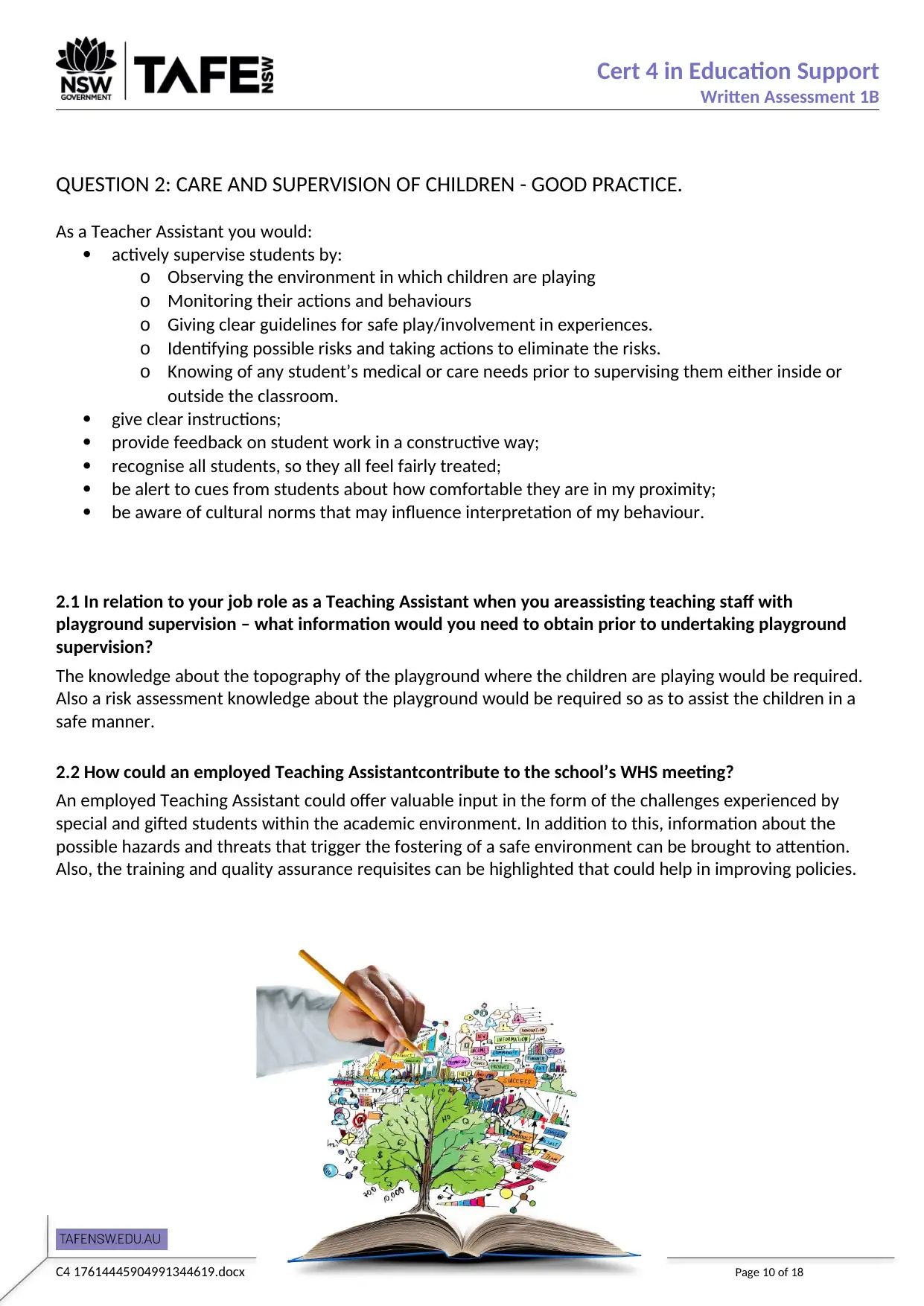
Cert 4 in Education Support
Written Assessment 1B
QUESTION 2: CARE AND SUPERVISION OF CHILDREN - GOOD PRACTICE.
As a Teacher Assistant you would:
actively supervise students by:
o Observing the environment in which children are playing
o Monitoring their actions and behaviours
o Giving clear guidelines for safe play/involvement in experiences.
o Identifying possible risks and taking actions to eliminate the risks.
o Knowing of any student’s medical or care needs prior to supervising them either inside or
outside the classroom.
give clear instructions;
provide feedback on student work in a constructive way;
recognise all students, so they all feel fairly treated;
be alert to cues from students about how comfortable they are in my proximity;
be aware of cultural norms that may influence interpretation of my behaviour.
2.1 In relation to your job role as a Teaching Assistant when you areassisting teaching staff with
playground supervision – what information would you need to obtain prior to undertaking playground
supervision?
The knowledge about the topography of the playground where the children are playing would be required.
Also a risk assessment knowledge about the playground would be required so as to assist the children in a
safe manner.
2.2 How could an employed Teaching Assistantcontribute to the school’s WHS meeting?
An employed Teaching Assistant could offer valuable input in the form of the challenges experienced by
special and gifted students within the academic environment. In addition to this, information about the
possible hazards and threats that trigger the fostering of a safe environment can be brought to attention.
Also, the training and quality assurance requisites can be highlighted that could help in improving policies.
C4 17614445904991344619.docx Last Updated: 7th December, 2017 Page 10 of 18
Written Assessment 1B
QUESTION 2: CARE AND SUPERVISION OF CHILDREN - GOOD PRACTICE.
As a Teacher Assistant you would:
actively supervise students by:
o Observing the environment in which children are playing
o Monitoring their actions and behaviours
o Giving clear guidelines for safe play/involvement in experiences.
o Identifying possible risks and taking actions to eliminate the risks.
o Knowing of any student’s medical or care needs prior to supervising them either inside or
outside the classroom.
give clear instructions;
provide feedback on student work in a constructive way;
recognise all students, so they all feel fairly treated;
be alert to cues from students about how comfortable they are in my proximity;
be aware of cultural norms that may influence interpretation of my behaviour.
2.1 In relation to your job role as a Teaching Assistant when you areassisting teaching staff with
playground supervision – what information would you need to obtain prior to undertaking playground
supervision?
The knowledge about the topography of the playground where the children are playing would be required.
Also a risk assessment knowledge about the playground would be required so as to assist the children in a
safe manner.
2.2 How could an employed Teaching Assistantcontribute to the school’s WHS meeting?
An employed Teaching Assistant could offer valuable input in the form of the challenges experienced by
special and gifted students within the academic environment. In addition to this, information about the
possible hazards and threats that trigger the fostering of a safe environment can be brought to attention.
Also, the training and quality assurance requisites can be highlighted that could help in improving policies.
C4 17614445904991344619.docx Last Updated: 7th December, 2017 Page 10 of 18
Paraphrase This Document
Need a fresh take? Get an instant paraphrase of this document with our AI Paraphraser
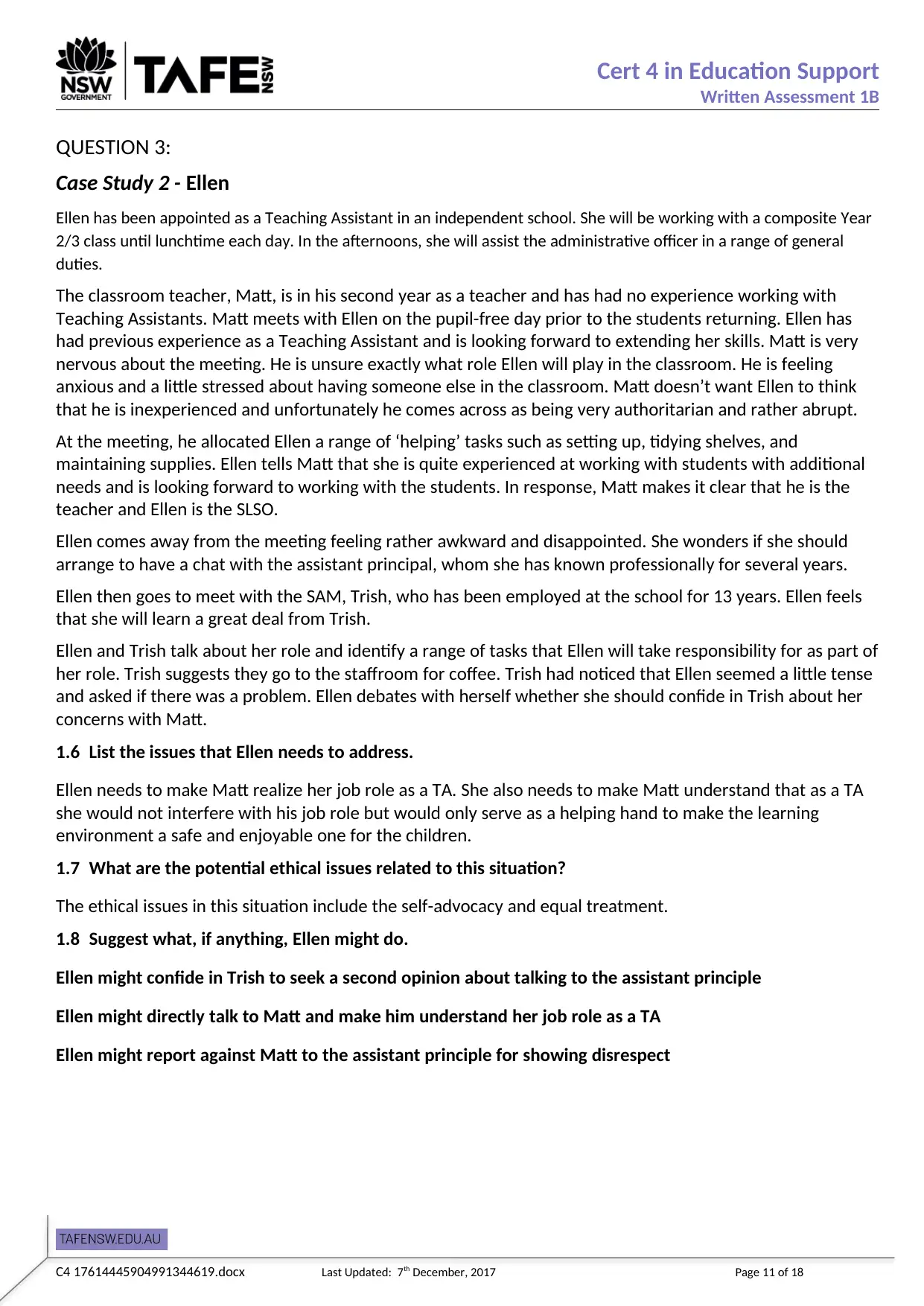
Cert 4 in Education Support
Written Assessment 1B
QUESTION 3:
Case Study 2 - Ellen
Ellen has been appointed as a Teaching Assistant in an independent school. She will be working with a composite Year
2/3 class until lunchtime each day. In the afternoons, she will assist the administrative officer in a range of general
duties.
The classroom teacher, Matt, is in his second year as a teacher and has had no experience working with
Teaching Assistants. Matt meets with Ellen on the pupil-free day prior to the students returning. Ellen has
had previous experience as a Teaching Assistant and is looking forward to extending her skills. Matt is very
nervous about the meeting. He is unsure exactly what role Ellen will play in the classroom. He is feeling
anxious and a little stressed about having someone else in the classroom. Matt doesn’t want Ellen to think
that he is inexperienced and unfortunately he comes across as being very authoritarian and rather abrupt.
At the meeting, he allocated Ellen a range of ‘helping’ tasks such as setting up, tidying shelves, and
maintaining supplies. Ellen tells Matt that she is quite experienced at working with students with additional
needs and is looking forward to working with the students. In response, Matt makes it clear that he is the
teacher and Ellen is the SLSO.
Ellen comes away from the meeting feeling rather awkward and disappointed. She wonders if she should
arrange to have a chat with the assistant principal, whom she has known professionally for several years.
Ellen then goes to meet with the SAM, Trish, who has been employed at the school for 13 years. Ellen feels
that she will learn a great deal from Trish.
Ellen and Trish talk about her role and identify a range of tasks that Ellen will take responsibility for as part of
her role. Trish suggests they go to the staffroom for coffee. Trish had noticed that Ellen seemed a little tense
and asked if there was a problem. Ellen debates with herself whether she should confide in Trish about her
concerns with Matt.
1.6 List the issues that Ellen needs to address.
Ellen needs to make Matt realize her job role as a TA. She also needs to make Matt understand that as a TA
she would not interfere with his job role but would only serve as a helping hand to make the learning
environment a safe and enjoyable one for the children.
1.7 What are the potential ethical issues related to this situation?
The ethical issues in this situation include the self-advocacy and equal treatment.
1.8 Suggest what, if anything, Ellen might do.
Ellen might confide in Trish to seek a second opinion about talking to the assistant principle
Ellen might directly talk to Matt and make him understand her job role as a TA
Ellen might report against Matt to the assistant principle for showing disrespect
C4 17614445904991344619.docx Last Updated: 7th December, 2017 Page 11 of 18
Written Assessment 1B
QUESTION 3:
Case Study 2 - Ellen
Ellen has been appointed as a Teaching Assistant in an independent school. She will be working with a composite Year
2/3 class until lunchtime each day. In the afternoons, she will assist the administrative officer in a range of general
duties.
The classroom teacher, Matt, is in his second year as a teacher and has had no experience working with
Teaching Assistants. Matt meets with Ellen on the pupil-free day prior to the students returning. Ellen has
had previous experience as a Teaching Assistant and is looking forward to extending her skills. Matt is very
nervous about the meeting. He is unsure exactly what role Ellen will play in the classroom. He is feeling
anxious and a little stressed about having someone else in the classroom. Matt doesn’t want Ellen to think
that he is inexperienced and unfortunately he comes across as being very authoritarian and rather abrupt.
At the meeting, he allocated Ellen a range of ‘helping’ tasks such as setting up, tidying shelves, and
maintaining supplies. Ellen tells Matt that she is quite experienced at working with students with additional
needs and is looking forward to working with the students. In response, Matt makes it clear that he is the
teacher and Ellen is the SLSO.
Ellen comes away from the meeting feeling rather awkward and disappointed. She wonders if she should
arrange to have a chat with the assistant principal, whom she has known professionally for several years.
Ellen then goes to meet with the SAM, Trish, who has been employed at the school for 13 years. Ellen feels
that she will learn a great deal from Trish.
Ellen and Trish talk about her role and identify a range of tasks that Ellen will take responsibility for as part of
her role. Trish suggests they go to the staffroom for coffee. Trish had noticed that Ellen seemed a little tense
and asked if there was a problem. Ellen debates with herself whether she should confide in Trish about her
concerns with Matt.
1.6 List the issues that Ellen needs to address.
Ellen needs to make Matt realize her job role as a TA. She also needs to make Matt understand that as a TA
she would not interfere with his job role but would only serve as a helping hand to make the learning
environment a safe and enjoyable one for the children.
1.7 What are the potential ethical issues related to this situation?
The ethical issues in this situation include the self-advocacy and equal treatment.
1.8 Suggest what, if anything, Ellen might do.
Ellen might confide in Trish to seek a second opinion about talking to the assistant principle
Ellen might directly talk to Matt and make him understand her job role as a TA
Ellen might report against Matt to the assistant principle for showing disrespect
C4 17614445904991344619.docx Last Updated: 7th December, 2017 Page 11 of 18
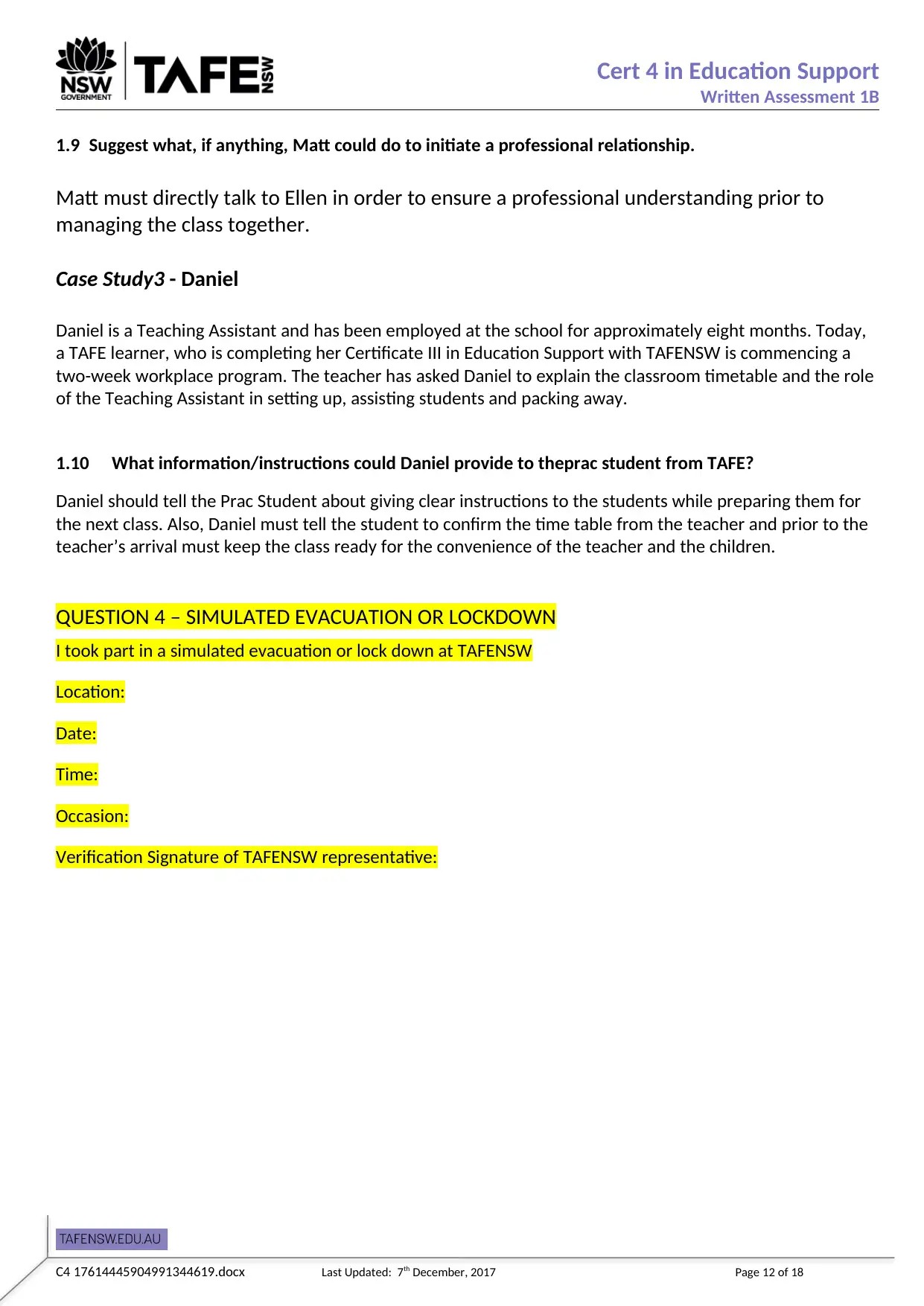
Cert 4 in Education Support
Written Assessment 1B
1.9 Suggest what, if anything, Matt could do to initiate a professional relationship.
Matt must directly talk to Ellen in order to ensure a professional understanding prior to
managing the class together.
Case Study3 - Daniel
Daniel is a Teaching Assistant and has been employed at the school for approximately eight months. Today,
a TAFE learner, who is completing her Certificate III in Education Support with TAFENSW is commencing a
two-week workplace program. The teacher has asked Daniel to explain the classroom timetable and the role
of the Teaching Assistant in setting up, assisting students and packing away.
1.10 What information/instructions could Daniel provide to theprac student from TAFE?
Daniel should tell the Prac Student about giving clear instructions to the students while preparing them for
the next class. Also, Daniel must tell the student to confirm the time table from the teacher and prior to the
teacher’s arrival must keep the class ready for the convenience of the teacher and the children.
QUESTION 4 – SIMULATED EVACUATION OR LOCKDOWN
I took part in a simulated evacuation or lock down at TAFENSW
Location:
Date:
Time:
Occasion:
Verification Signature of TAFENSW representative:
C4 17614445904991344619.docx Last Updated: 7th December, 2017 Page 12 of 18
Written Assessment 1B
1.9 Suggest what, if anything, Matt could do to initiate a professional relationship.
Matt must directly talk to Ellen in order to ensure a professional understanding prior to
managing the class together.
Case Study3 - Daniel
Daniel is a Teaching Assistant and has been employed at the school for approximately eight months. Today,
a TAFE learner, who is completing her Certificate III in Education Support with TAFENSW is commencing a
two-week workplace program. The teacher has asked Daniel to explain the classroom timetable and the role
of the Teaching Assistant in setting up, assisting students and packing away.
1.10 What information/instructions could Daniel provide to theprac student from TAFE?
Daniel should tell the Prac Student about giving clear instructions to the students while preparing them for
the next class. Also, Daniel must tell the student to confirm the time table from the teacher and prior to the
teacher’s arrival must keep the class ready for the convenience of the teacher and the children.
QUESTION 4 – SIMULATED EVACUATION OR LOCKDOWN
I took part in a simulated evacuation or lock down at TAFENSW
Location:
Date:
Time:
Occasion:
Verification Signature of TAFENSW representative:
C4 17614445904991344619.docx Last Updated: 7th December, 2017 Page 12 of 18
⊘ This is a preview!⊘
Do you want full access?
Subscribe today to unlock all pages.

Trusted by 1+ million students worldwide
1 out of 18
Related Documents
Your All-in-One AI-Powered Toolkit for Academic Success.
+13062052269
info@desklib.com
Available 24*7 on WhatsApp / Email
![[object Object]](/_next/static/media/star-bottom.7253800d.svg)
Unlock your academic potential
Copyright © 2020–2025 A2Z Services. All Rights Reserved. Developed and managed by ZUCOL.





